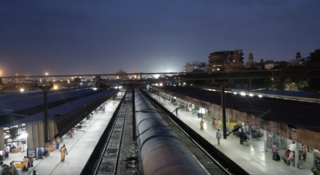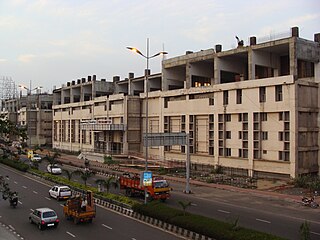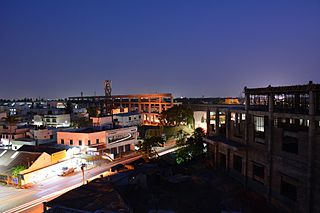
The Chennai Mass Rapid Transit System, a state-owned subsidiary of Indian Railways, is a metropolitan elevated railway line in Chennai, India. Operated by the Southern Railways, it is the first elevated railway line in India and also the country's longest elevated corridor spanning 17 km. Although it is segregated from the Chennai Suburban Railway, they both are operated by Southern Railway and are integrated in a wider urban rail network. Built at a cost of ₹ 15,710 million, the line runs within the city limits from Chennai Beach to Velachery, covering a distance of 19.34 km (12.02 mi) with 18 stations, with an average daily ridership of 100,000 commuters. Connecting the central business area of old Madras with the IT corridor, the section has a potential capacity of 425,000 passengers a day. In 2011–2012, MRTS registered a revenue of ₹ 198.9 million, registering a 16.25 percent increase, with 134 trains plying across all the 17 stations.

Adambakkam is a neighbourhood of Chennai, India. It is primarily a residential locality situated in South Chennai. Adambakkam area comes under Velachery taluk and Alandur taluk, Chennai District of Chennai Corporation. Adambakkam is surrounded by areas namely, Alandur in the North-West, Nanganallur in the West, Madipakkam in the South, Velachery in the East and Guindy in the North. Earlier, one part of Adambakkam was under the direct governance of Chennai Corporation. From October 2011 onwards, the entire area was merged with the Chennai Corporation. Upon completion of the MRTS extension line, the neighbourhood will be served by Adambakkam railway station. Its Proximity to commercial localities like Velachery, accessible railway stations, Metro Stations and road transport routes makes Adambakkam an ideal choice of location to live.

Transport in Chennai includes various modes of air, sea, road and rail transportation in the city and its suburbs. Chennai's economic development has been closely tied to its port and transport infrastructure, and it is considered one of the best infrastructure systems in India.

Parangimalai is a small hillock in Chennai, Tamil Nadu, India, near the neighbourhood of Guindy and very close to Chennai International Airport.

Puratchi Thalaivar Dr. M.G. Ramachandran Central Railway Station, commonly known as Chennai Central, is the main railway terminus in the city of Chennai, Tamil Nadu, India. It is the busiest railway station in South India and one of the most important hubs in the country. It is connected to Moore Market Complex railway station, Chennai Central metro station, Chennai Park railway station, Chennai Park Town railway station and is 2 km from Chennai Egmore railway station. The terminus connects the city to northern India, including Kolkata, Mumbai, New Delhi and Ahmedabad as well as to Bangalore, Coimbatore, Hyderabad and different parts of Kerala.

Velachery is a commercial and residential area in south Chennai, and is the largest commercial centre in south Chennai. It is surrounded by Guindy in the north, IIT Madras in the north-east, Taramani in the east, Perungudi in the south-east, Pallikaranai Wetland in the south, also Madipakkam in the south and south-west, Adambakkam in the west and north-west. The growth of the neighbourhood during the last decade can be cited due to the growth of the IT sector in south Chennai. It acts as an important hub connecting the rapidly growing business-class information technology corridor popularly called the OMR; the more mature and very well-connected GST road and the central business districts of the city, which has more relevance to the history of Chennai. Velachery as a whole draws a perfect balance between old and new Chennai and is a phenomenon in terms of growth and development.

The Chennai Metro is a rapid transit system serving the city of Chennai, Tamil Nadu, India. It is the fourth longest metro system in India after Delhi Metro, Hyderabad metro and Namma Metro. The system commenced service in 2015 after partially opening the first phase of the project. The network consists of two colour-coded lines covering a length of 54.65 kilometres (33.96 mi). The Chennai Metro Rail Limited (CMRL), a joint venture between Government of India and the Government of Tamil Nadu built and operates the Chennai Metro. The system has a mix of underground and elevated stations and uses standard gauge. The services operate daily between 4:30 and 23:00 with a varying frequency of 5 to 14 minutes.
Puzhuthivakkam, commonly known as Ullagaram or Ullagaram–Puzhuthivakkam, is a southern neighbourhood of Chennai in Tamil Nadu, India. Puzhuthivakkam loosely translates to dust neighborhood. The neighbourhood is part of the Greater Chennai Corporation, following Chennai's expansion into Kanchipuram district. Puzhuthivakkam is located between the neighborhoods of Madipakkam, Adambakkam, Velachery, Pallikaranai, and Nanganallur. Puzhuthivakkam was initially developed in the late 1960s and early 1970s. Upon completion of the MRTS extension line, the neighborhood will be served by Puzhuthivakkam railway station. As of 2011, the town had a population of 53,322.

Chennai Beach is a railway terminus of the Southern Railway network in Parry's Corner, Chennai, India. Built on reclaimed land, the station serves the suburban services of the Chennai Suburban Railway and Mass Rapid Transit System (Chennai) and a few passenger trains. It serves as the northern terminus for the Chennai MRTS line. The station is named after High Court Beach, which was later built up as part of Chennai Port, and not after the Marina Beach, which is located a few kilometres away and is served by Chepauk, Triplicane and Lighthouse stations of the MRTS line. The station consists of 1500 square metres of open parking area.

The Chennai Suburban Railway is a commuter rail system in the city of Chennai, Tamil Nadu, India, operated by the Indian Railways. It is the second largest suburban rail network in terms of route length and the third largest in terms of commuters in India. Around 1,000 services are operated daily between 4:00 a.m. and midnight. It is the longest suburban circular route in India covering of 235.5 km (146.3 mi).

Anna Salai, formerly known as St. Thomas Mount Road or simply Mount Road, is an arterial road in Chennai, India. It starts at the Cooum Creek, south of Fort St George, leading in a south-westerly direction towards St. Thomas Mount, and ends at the Kathipara Junction in Guindy. Beyond the Kathipara Junction, a branch road arises traversing westwards to Poonamallee to form the Mount-Poonamallee Road while the main branch continuing southwards to Chennai Airport, Tambaram and beyond to form Grand Southern Trunk Road. Anna Salai, which is more than 400 years old, is acknowledged as the most important road in Chennai city. The head offices of many commercial enterprises and public buildings are located along Anna Salai. It is the second longest road in Chennai, after EVR Periyar Salai.
Chennai Monorail was a proposal for a number of lines as part of mass transit system for the Indian city of Chennai. Originally the city planned to use monorail on all lines but many were subsequently changed to railways as part of the Chennai Metro.

Tambaram is one of the railway terminals of the Chennai Beach–Tambaram section of the Chennai Suburban Railway Network. It is situated at a distance of 6 kilometres (3.7 mi) from the centre of Tambaram. It is situated in South Chennai and located 27 kilometres (17 mi) from broadway. It is one of the fastest-growing railway hubs outside Chennai Central in the southern direction. Every day, on an average, around 3,50,000 commuters use the station. About 500 suburban electric trains operate from Tambaram, including those between Chennai Beach and Chengalpattu and Kancheepuram. Further, more than 25 expresses, including those bound for Howrah and other places in the north pass through the town. It is also third busiest station in the city. It is one of the four railway terminals within Chennai City. The daily ticket sales at Tambaram fetch ₹ 1 million, half of which comes from suburban travellers. It is the second most revenue-generating station in Chennai after Moore Market Complex. A total of 52 trains pass through the station.
Thiruvananthapuram Metro also known as Capital Metro is a proposed Light Rapid Transit (LRT) system in the city of Thiruvananthapuram, the capital of the Indian state of Kerala.

The Velachery MRTS Station is a ground level station on the Chennai MRTS railway line in Chennai. It is located near the junction of Velachery Main Road and Inner Ring Road in Velachery. The station is built on the northern banks of Pallikaranai wetland.

Thiruvanmiyur is a station on the Chennai MRTS in India. Located opposite the Tidel Park on Rajiv Gandhi Salai at Taramani, it exclusively serves the Chennai MRTS.

Taramani is a railway station on the Chennai MRTS in Chennai, India. Located off MGR Main Road in Taramani, it exclusively serves the Chennai MRTS.

Mundakakanniamman Koil station is a railway station on the Chennai MRTS, located near Brindavan Street and Mundakakanni Amman Koil Street in Mylapore, along the Buckingham Canal. The station exclusively serves the Chennai MRTS, and serves the neighbourhood of northern Mylapore, Santhome and Royapettah.
St. Thomas Mount railway station, or Mount railway station, is one of the railway stations of the Chennai Beach–Chengalpattu section of the Chennai Suburban Railway Network. It serves the neighbourhood of St. Thomas Mount and Pazhavanthangal, which are suburbs of Chennai. It is located at a distance of 17 km (11 mi) from Chennai Beach terminus, with an elevation of 11 m (36 ft) above sea level.

Adambakkam is a station under construction on the Chennai MRTS. The station exclusively serves the Chennai MRTS and serves the neighbourhood of Adambakkam.

















